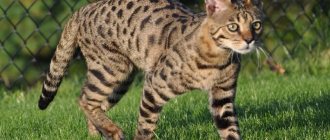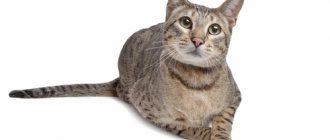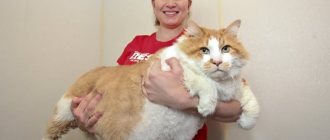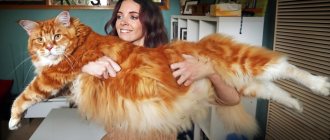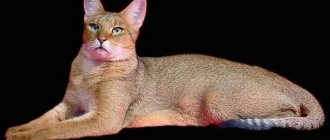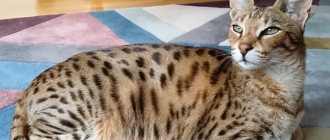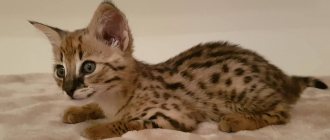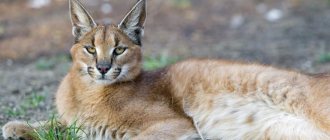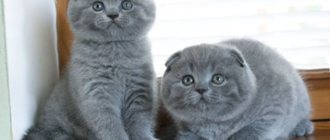- Posted by Dmitry Redkin
- Date: May 18, 2018
The birth of many breeds of pets is due to the desire of a person to have a domestic cat with the appearance of a predator. To meet this need, breeders work tirelessly. They seemed to have success with the Savannah cat.
- 2 Description of the savannah
2.1 Photo gallery: savannah colors - 2.2 Savannah or Bengal
- 3.1 Video: Savannah walks on a leash
- 4.1 Author's experience: savannah living in Siberia
- 6.1 Feeding the savannah
History of the breed
The history of the origin of many cat breeds is shrouded in mystery. Savannah is lucky in this sense. The date of appearance of the first kittens of this breed is documented - April 1, 1986.
In the 80s of the last century in America it was very fashionable to keep wild serval cats at home. One day, the owner of one nursery, Judy Frank, asked another owner, Susie Woods, for a Serval cat to breed with her pets. No one could have imagined then that the Siamese (according to another version - a simple domestic) cat, who lived with Judy as a free pupil, would become pregnant by a serval and give birth to a lovely spotted kitten. Considering that the gestation period for wild African cats is 10 days longer than for Siamese cats, then this case is unique, as is the mating process.
A unique breed arose from the accidental connection of a wild serval and a domestic cat.
The girl born was given the name Savannah. Perhaps this would have been the end of it, but an unusual cheetah-like cat caught the eye of the famous breeder Patrick Kelly. He bought spotted kittens born from Savannah and convinced one of the Serval breeders to start breeding a new breed. After 10 years of hard work, the first breed standards were determined. And in 1996, the newly created breed was presented at an international exhibition. The breed was registered in 2001, and the Savannah received official status in 2003, and a year later - the status of a new, “advanced” breed.
In 2015, the Savannah was recognized as the most expensive cat.
Features of development
It is known that the gestation period for ordinary domestic cats is about 65 days, and for the Serval - up to 77. As a result of this difference, hybrids of earlier generations are often born prematurely, and therefore urgently need additional nursing. The litter of hybrids of the first two generations usually consists of 1-2, and the subsequent ones - of 3-5 kittens. Savannah cats can become pregnant as early as 4 weeks after giving birth, however, breeders themselves limit the number of matings to two or three per year.
These animals feed their kittens with milk for up to 8-12 weeks. At first, babies will almost always sleep. In this state, their body is aimed at maximizing the production of growth hormone. This is why it is not recommended to wake or disturb kittens in any way during this period. Once they reach the age of 10-12 weeks, they are spayed or neutered in order to be soon transferred to new owners.
Description of the savannah
Savannah is the only cat breed to which the concept of “standard” does not apply. There is only a general description of the breed and basic requirements. But there are a lot of tolerances in the size and location of spots, ear shape and color. In fact, the Savannah is an expensive hybrid of the Serval with other cats.
The appearance and cost of kittens directly depend on what percentage of the blood of the wild African Serval cat carries the offspring. Accordingly, the requirements for different litters from different cats cannot be the same.
To obtain hybrid offspring of savannas, cats of various breeds are used
All savannas are characterized by the following features:
- the head is small relative to the body, triangular in shape;
- high-standing, large, rounded ears, almost meeting at the base; light spots on the ears are considered a sign of the breed;
- wide, slightly convex nose, the earlobe is lowered;
- the body is elongated, lean, the chest is wide, powerful, the groin area is clearly defined;
- the legs are thin, long, muscular, the hind limbs are longer than the front ones, the paw pads are always dark in color;
- the tail is straight, medium length, brightly colored;
- oval eyes with black edging;
- The coat is coarse and elastic with a thick undercoat.
Savannah is one of the largest cats. Body length can reach 1 m, height at the withers up to 60 cm, weight up to 15 kg.
Light spots on the ears of the Savannah are a breed characteristic
The coat color is necessarily spotted, it can be:
- chocolate;
- golden;
- brown;
- tabby;
- red-brown.
Black savannas are highly valued. Among the unusual colors - lilac, marble. The color of the litter depends on the breed of cat with which the serval is crossed.
Photo gallery: savannah colors
Savannah lilac color is rare
In black savannahs, spots on the fur will only be visible in good lighting.
Brown savannas are the most popular
Silver color is the second most popular color among savannah owners
Savannah or Bengal
The popularity of “leopard” cats is gaining momentum. Many people, who have the means, want to have a predator at home, preferably a decorative one. Selectors and breeders can offer a choice of several breeds of cats that resemble wild predators. One of them is a Bengal cat.
The genotype of the Bengal cat is based on the Asian leopard cat, while the Savannah cat is derived from the Serval bush cat. The Serval is larger than the Asian cat, and accordingly, the first generations of the Savannah are larger than those of the Bengals. Both of them are distinguished by a magnificent spotted skin, but the serval has single-color spots, while the Bengal cat has tri-colored spots. And, of course, even outwardly they are very different. The Savannah has a sinewy, muscular body on thin strong legs, a triangular, small head with large ears. In appearance it resembles a cheetah. The Bengal is more compact: the body is large, strong, the paws are powerful, large, the muzzle is wide, the ears are medium-sized, rounded, tilted forward.
If we draw analogies with people, then the Savannah is more likely to be an athlete, and the Bengal is more likely to be a wrestler.
Bengal is a dense and large wrestler in appearance
What is the difference between a Savannah and a Bengal cat?
Despite the similarities in appearance, the Savannah cat and the Bengal cat have a number of significant differences.
- The pedigree of Bengal cats originates from the Far Eastern cats, and in the savannas - from African servals.
- If you look closely at Savannahs and Bengals, differences in the coloring of the skin are visible to the naked eye. In Bengals it is dotted with dark spots of three different colors. Savannahs have spots of the same tone.
- Distinctive features are manifested in the structure of the body. The Bengal breed has a compact body, like an American football player. These are cats with small ears and large round eyes. But Savannah is compared to a tall basketball player. They have big ears.
Savannah character
Everyone who has ever dealt with a savannah notes the high intelligence of this cat. Possessing a fairly calm temperament, they are sociable and inquisitive; they easily find a common language with other pets. If there are several animals in the house, the savannah creates a team around itself, in which it will certainly be the leader.
Savannah is especially friendly to dogs. Probably because they are very similar. Savannah dog habits affect everything. First of all - in relation to the person. They, like dogs, become attached to their owner and are ready to follow him to the ends of the earth. They love to walk on a leash. They learn to follow dog commands easily and with pleasure.
They love active games about hunting. The breed is based on the serval, which in the wild hunts frogs and fishes. Therefore, savannahs are not afraid of water and swim well. It costs jumping cats nothing to overcome a three-meter height.
Video: Savannah walks on a leash
These cats are very talkative; they have a wide range of sounds in their arsenal: meowing, growling, squeaking, snake hissing and chirping.
Since this cat becomes an adult only at the age of three, its character may change during this time. A playful, calm pet may exhibit characteristics of a wild animal. Therefore, you should not leave children alone in the savannah.
Even the calmest Savannah cat can show a “brutal” character
Since this breed is still in its infancy, it is difficult to determine in advance the character of the future generation. One litter can produce kittens with very different temperaments. Early socialization is very important in the proper education of this semi-wild cat. A kitten, accustomed to interacting with people from early childhood, will most likely become a companion and friend later.
Content Features
Before such a Savannah cat appears in the house (the photo shows its external features), it is necessary for all family members to get together and discuss the rules for handling the animal in order to develop a unified principle for its upbringing. If there are many rooms in the house, then you should first keep the kitten in one or two, and over time introduce him to the rest of the rooms. In this case, it would be advisable to place several trays at once in different parts of the house.
If Savannah cats are kept in an apartment above the second floor, then all mosquito nets should be strengthened as much as possible. The fact is that both the base and their fastenings are made of plastic, so if animals show excessive interest in birds, insects, etc. flying outside the window, then they can fall out and, having landed on it, receive various types of injuries .
We should not forget about poisonous indoor plants. They will need to be kept as far away from the overly curious kitten as possible. In addition, for at least seven months, you will have to secure or hide the wires of electrical appliances, since during this time Savannahs can use them as teethers. Do not underestimate the usual safety measures: be sure to close containers with water, packs of washing powder and other household chemicals, and remove valuable and breakable items.
Health
Savannah is unique here too - it is the only artificially bred breed that is completely devoid of genetic diseases. There are two reasons for this: the natural immunity and health of the serval and, since this is a hybrid breed, the lack of interkinship.
To maintain good physical shape, the Savannah needs to move a lot and be active.
Kittens need to have all their vaccinations and deworming done on time. With good care and physical activity, Savannahs can live up to 17–20 years.
Author's experience: Savannah living in Siberia
Savannah is a heat-loving creature. It is believed that the descendant of the African cat will not be able to live in a cold climate. The story of one Savannah named Zosya proves that each animal of this breed is unique and does not want to fit into the generally accepted framework.
It all started with the fact that one of my wealthy acquaintances, having read specialized literature, wanted to have a savannah at home. He lives in Siberia, his cottage is located far outside the city, almost in the taiga. All the warnings that an expensive cat would not survive in our conditions and 18 thousand dollars could be wasted had no effect. The kitten was ordered from one of the American nurseries. How a 4-month-old baby survived a multi-hour flight is a mystery. I met the owner with the kitten at the airport. Judging by the mood and condition of the small animal, the only thing that bothered him was hunger.
Having entered the household and looking around a little, Zosya went straight to... the doghouse. We read, of course, that savannahs quickly find a common language with dogs, but not so much! It is not known what language the Siberian wolfhound and the little savannah spoke, but it took them less than half an hour to become bosom friends. Growing up, Zosya felt more and more like the mistress of the house. She did not allow herself any special liberties, but she treated all members of the household, except the owner, with undisguised contempt. Having occupied the owner's pool, she loves to take water procedures alone and gets very angry if she is disturbed.
When the first snow began to fall, Zosya’s joy knew no bounds. The African woman fell in love with playing snowballs. Of course, she cannot, like a lynx, live in the cold in the snowy taiga. But in any weather she demands that she be allowed to visit the wolfhound Rudolf, who lives in the yard, every day.
For the first year, Savannah Zosya was under constant supervision of a personal veterinarian. According to him, the heat-loving cat has adapted perfectly to the Siberian climate.
Pros and cons of the breed
Pros:
- Non-standard, exotic appearance.
- Intelligence and natural curiosity.
- Unlimited loyalty to the owners.
- They are easy to train.
- Relatively unpretentious in care.
- Peaceful - gets along well with other cats and dogs.
- They quickly adapt to new conditions, so they are easy to travel with.
Minuses:
- High price.
- You need to walk them a lot, like dogs.
- Sometimes extremely mobile.
- Willful and independent.
- Due to its large size and active behavior, it is not recommended to have it in a home with small children.
Choosing a small savannah
Of course, you should only purchase such exotic and expensive kittens from professional breeders. A kitten should be adopted at 3-4 months of age. By this time, all necessary vaccinations must be completed. A prerequisite is that all Savannah kittens undergo an aggressiveness test at 3 months of age. Only animals that have passed the “exam” for tolerance to humans are allowed to be kept at home. According to existing rules, completely “wild” individuals must be euthanized. But not all breeders follow these rules. Be sure to check your parents' documents. It’s better to see them yourself and check their pedigree.
Evaluate the kittens' living conditions and diet. Kids should be well-fed, playful, and sociable. Do not take an aggressive, hissing kitten: this will never grow into a good-natured hunter, which an adult savannah should be.
When choosing a kitten, be careful, pay attention to its parents and conditions of detention
Savannah kittens are quite expensive. Where there is big money, there is a high probability of deception. Having a pedigree is not a guarantee that they will sell you a purebred kitten. In order not to fall for the bait of scammers, you need to know the external characteristics of the breed, although in small Savannahs they are not yet sufficiently pronounced. Therefore, pay attention to the pattern and color of the coat. The only color allowed for this breed is spotted. Only in black savannahs can the spots be weakly expressed. Unacceptable: marbled color, tricolor spots in the form of rosettes, white spots. Parallel stripes run from the head to the shoulder blades and fan out towards the tail on the back.
Optional equipment
Savannah cats love to jump and climb, so you need to take care of at least special multi-level shelves on the walls. In private homes, a safe and spacious enclosure can be equipped for them. It can accommodate not only shelves, but also a whole tree. It is worth noting that permanently keeping an animal in an enclosure is simply unacceptable. Such cats need daily one- or two-hour walks. It must be remembered that their free range is highly undesirable.
Usually, a scratching post is also placed near the feeding area. It is not so important what configuration it will be, but most often it is a tall pillar with a small platform at the top. It would be a good idea to ask which scratching post the kitten is already used to. As a rule, the Savannah cat (photo) is very smart, so it is quite easy to retrain him: you just need to use a spray containing valerian or catnip.
How to care for a hybrid cat
Savannah is a very large cat and requires a lot of space and equipment for active play. Such a pet is not suitable for keeping in an apartment. He will be more at ease in a private house, where it is possible to keep a cat indoors during the cold season, and in a spacious enclosure in the summer.
The dense, short savanna coat with a thick undercoat does not mat and does not require daily combing; it is enough to walk through the coat with a stiff brush once a week to remove dead hairs. It is necessary to keep the large ears clean and, when dirty, clean them with a soft cloth. Regular brushing of teeth is a must. The cat needs to be accustomed to it from childhood.
Unlike its counterparts, the savannah loves water, so there will be no problems with swimming. It is not recommended to wash your cat too often, but it is worth regularly organizing water parties for it; you can equip a special pool for the animal on the site.
Savannahs love water, you can even build a pool for it on your property
It is necessary to take into account the dimensions of the savanna when installing a toilet. Most likely, you will have to make a large tray with your own hands and take into account that a savannah needs much more litter than an ordinary cat. You will also need to negotiate with your semi-wild pet about spreading the litter yourself. The best thing to do is to train your Savannah to use the toilet. To do this, you need to make a special cover with a small hole on it.
Feeding the savannah
There are two opinions regarding the nutrition of the savannah. Some suggest feeding your hybrid cat premium dry food, while others suggest sticking to a natural diet. There is no doubt that the Savannah, as a direct descendant of the wild cat, needs a lot of meat. This should be taken into account when choosing a natural diet.
Savannah will need to be fed meat
The diet should include:
- various cereal porridges with boiled meat;
- raw meat;
- offal (liver, lungs, heart);
- turkey;
- chickens;
- fish (infrequently, but regularly).
When feeding naturally, be sure to use vitamin and mineral supplements.
Proper nutrition is balanced, which will ensure good health for the cat and prolong its life.
Rules of care and nutrition
How to properly care for a savannah?
Care
Animals of the Savannah breed are not demanding in terms of hair care. To make your cat feel confident and well-groomed, it is enough to brush it once a week with special brushes. At the same time, during the molting period, you will have to carry out this procedure daily.
In addition, provide her with eye care by washing them once a week with cotton pads soaked in special solutions, which are available today at any veterinary pharmacy. And, of course, bathe your beauty weekly - because they love playing on the water so much. For this, your pet will thank you with her cheerful disposition and love.
Indoors, cats prefer to occupy places at the top, so remove from the mezzanines everything that would be a pity to see broken. Don’t be under any illusions, the Savannah cat conquers the three-meter bar no worse than the famous Olympian athlete.
These animals love to chew on everything, so in order to protect your pet’s health, make sure that there are no plants in the house that contain alkaloids, such as violet or milkweed.
Nutrition
Savannahs are also unpretentious when it comes to food. The best diet for savannas is equal proportions of proteins, vegetables, fruits and cereals. If you add special food to their diet, be sure to purchase super premium food. In addition, representatives of this breed always need raw meat, preferably lean poultry, veal and beef.
Also, do not forget about vitamin-mineral complexes, yeast, table salt and sprouted grains, which are rich in vitamin B.
Avoid giving your cheetah pet food that contains a lot of grain. The digestive system of savannahs does not digest cereals well. Another taboo relates to milk and fermented milk products, as they can cause digestive system problems for cats.
Advice! If you don’t have time to understand the peculiarities of feeding a Savannah and calculate calories and nutritional balance for your cat, switch it completely to super-premium food. After this, you will be required to do two things - add food and add fresh water.
Breeding Savannah cats is for professionals
The process of breeding Savannah cats is very complex and is only available to professional breeders. This is why this breed is so rare and expensive. Since this is a hybrid breed, a wild Serval is required to produce the first offspring. With each new generation, the genes are lost, and the Savannah becomes like an ordinary cat. Until the fourth generation, males are sterile. This also makes reproduction difficult.
The following levels of offspring are accepted by felinologists:
- first generation (F1) from a wild serval and a domestic cat, the gene pool is divided 50/50%;
- second generation (F2) from crossing F1 with a domestic cat, here the wild cat genes are no more than 30%;
- third generation (F3) - serval + F2, wild genes up to 13%.
After the third generation, further matings do not make sense; a new African cat is required.
Thus, a beautiful and intelligent Savannah cat is purchased only for pleasure, and not for breeding.
Where to buy a savannah kitten
The nursery “A1 SAVANNAHS”, created by Joyce Sroufe, a breeder, is considered the best in terms of the breed’s gene pool today.
In general, it is difficult to buy a savannah. Not only is this a young and popular breed, it is also expensive. If you look at the matter only from the financial side, then the Savannah is the most expensive among all the cats that are sold in the world at the moment.
But the matter does not stop there. The price of Savannah varies widely within the breed itself. For example, kittens of the first generation can be sold for $25,000, and a representative of the third – already $5,000.
Medical problems
Having decided to get such a cat, you must take into account that walking in an enclosure or on a leash requires additional both financial and time costs: accustoming to the street, maintaining the enclosure, preventive examination by a veterinarian, deworming, additional vaccinations, etc. A trip to the veterinary clinic with The savannah of the first two generations often turns out to be a problematic undertaking both for the animal itself and for its owner.
No special health problems have been identified in representatives of this breed, with the exception of those that are inherent in other domestic cats. Usually, all difficulties that arise can be resolved by regular veterinary examinations, timely vaccinations, high-quality balanced nutrition and good care.

